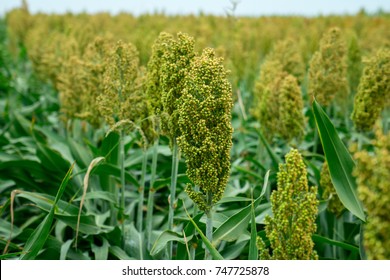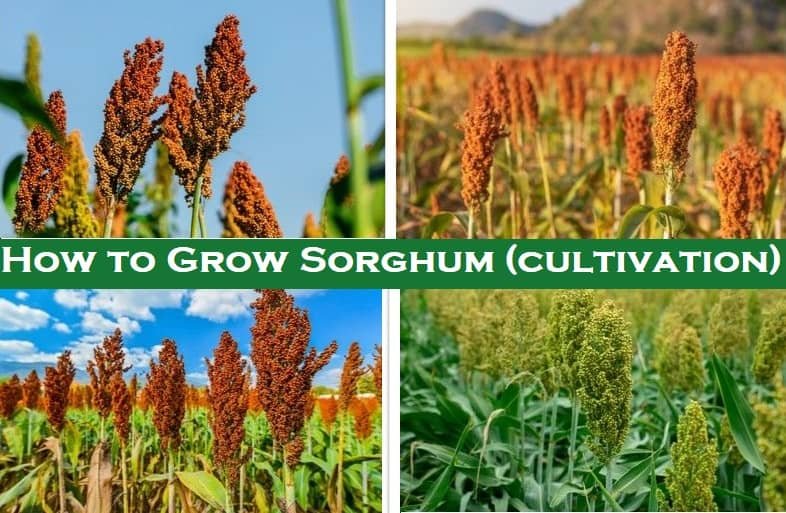In this article, we’ll learn how to grow sorghum/sorghum cultivation following 9 steps.

Sorghum
- Common name: great millet, durra, jowar, Sorghum.
- Scientific name: Sorghum bicolor.
- Family: Poaceae.
- Origin: The origin of sorghum took place in North-Eastern Africa.
Importance
Sorghum or jowar is one of the vital food and fodder cereal crops. The nutritional value of sorghum is the same as that of corn, which is why it is gaining importance as livestock feed. Sorghum (or) Jowar is also used for ethanol production, producing grain alcohol, starch production, production of adhesives and paper other than food and feed for livestock. Jowar (or) Sorghum cultivation is gaining popularity due to its nature of extreme drought tolerance. Sorghum is very nutritious, just like corn, and can be used as green fodder, dry fodder, hay, or silage.
Varieties
Some Indian varieties are PC-6, 9, 23, HC -171, 260 (Early to medium duration), U.P. Chari 1 & 2, CO-27 etc.
How to Grow Sorghum (sorghum cultivation)
1. Climate/site selection
Basically, jowar or sorghum is a tropical crop. Sorghum thrives well at temperatures between 25°C and 32°C but below 16°C is not good for the crop. Jowar crop requires rainfall of about 40 cm annually. Jowar is an extreme drought-tolerant crop and recommended for dry regions. Too many moist and prolonged dry conditions are not suitable for sorghum cultivation.
2. Soil preparation
Sorghum crop adapts the wide range of soils but grows well in sandy loam soils having good drainage. Soil pH range of 6 to 7.5 is ideal for its cultivation and better growth. The main field should be plowed and leveled to a fine tilth for weeds-free sowing.
3. Land preparation
One should avoid rocky field and 1-2 ploughing followed by 2 crosswise harrowings are required to prepare a good seedbed.
4. Seed rate and sowing method
A seed rate of 35-40 kg per hectare is well enough, and sowing should be carried out by drilling @ rowtorow distance of 25 cm. Seed broadcasting should be avoided. The seed should not be sowed more than 2–3 cm in depth.
5. Fertilizer Application
For 1 Hectare of land; FYM (Farm Yard Manure) – 10-15 tone. At the time of sowing, basal application of;
- N – 60 Kg.
- P2O5 – 40 kg.
- K2O – 40 kg.
Apply 35 kg N/ha top dressing 1 month after sowing. 60-65 kg N/ha should be applied in low rainfall and rainfed areas at sowing time. In Sulphur deficient soils, 45-60 kg S/ha should be added.
6. Irrigation
If the crop is sown in monsoon time (July), it may require l to 3 irrigations depending upon rains. For summer crops, 6 to 7 irrigations may be carried out due to high temperature. Rabi season crops need about 4 to 5 irrigations. Critical stages of irrigation are (For Rabi season)
- 30-45 days (seedling elongation stage).
- 60-65 days (reproductive or heading stages).
- 70-75 days (panicle emergence).
- 90-95 days (grain development stage).
However, suppose only one irrigation is available. In that case, this should be applied just before booting (40-50 days) from flowering at 10 days interval or Dithane M 45 – 0.2 % + Bavistin 0.2 % twice at 10 days interval after commencement of flowering.
7. Weed control
To control the weeds in the Sorghum crop, weeder cum mulcher should give 1 hoeing @ 3 weeks crop stage. Should use preemergence application of atrazine @ 0.50 kg/ha in 650 litres of water to control the weeds effectively.
8. Diseases and Insects
Sorghum crops are prone to many insects and diseases. Insects/pests in sorghum are stem borer, shootfly, & sorghum midge.
- Use spray of carbofuran/malathion @ 125 ml/ha, to control sorghum midge
- Use a spray of endosulfan @ 0.075. Diseases in Sorghum are Sooty stripe, anthracnose and zonate leaf spot.
- Spray carbendazim @ 5 grams /litre water to control anthracnose disease in early stages.
- Summer sown crop is very prone to shoot fly. Therefore, this carbofuran 3G @ 3 to 4 kg/ha should be applied to control shoot fly at sowing time.
- The crop should be sown during the July season to control or avoid stem borers
- . Using a spray of endosulfan @ 0.05%, 2 to 3 times at 10 to 14 days interval is also effective.
9. Harvesting (how long does sorghum take to grow?)
- The crop will be ready in single cut varieties for harvesting @ 65 to 75 days after sowing (50%, flowering stage).
- In multi-cut varieties, the first cut should be done @ 45-50 days, and subsequent cuts should be carried at 1-month intervals.
Yield
- Good farm management practices and a good variety of Sorghum/ Jowar can yield up to 1000 kg/ha.

